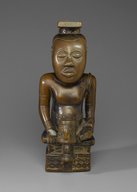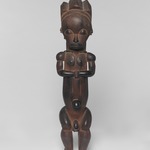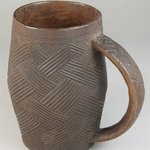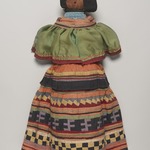

Kuba (Bushoong subgroup) artist. Ndop figure depicting Nyim Mbó Mbóosh (r. ca. 1650), Nyim Mishé miShyááng máMbúl (r. ca. 1710), or Nyim Kot áNée (r. ca. 1740), ca. 1760–1780. Wood (Crossopteryx febrifuga), tukula, fiber, 19 1/2 × 8 × 10 in. (49.5 × 20.3 × 25.4 cm). Brooklyn Museum, Purchased with funds given by Mr. and Mrs. Alastair B. Martin, Mrs. Donald M. Oenslager, Mr. and Mrs. Robert E. Blum, and the Mrs. Florence A. Blum Fund, 61.33. Creative Commons-BY (Photo: Brooklyn Museum, 61.33_front_PS2.jpg)

Kuba (Bushoong subgroup) artist. Ndop figure depicting Nyim Mbó Mbóosh (r. ca. 1650), Nyim Mishé miShyááng máMbúl (r. ca. 1710), or Nyim Kot áNée (r. ca. 1740), ca. 1760–1780. Wood (Crossopteryx febrifuga), tukula, fiber, 19 1/2 × 8 × 10 in. (49.5 × 20.3 × 25.4 cm). Brooklyn Museum, Purchased with funds given by Mr. and Mrs. Alastair B. Martin, Mrs. Donald M. Oenslager, Mr. and Mrs. Robert E. Blum, and the Mrs. Florence A. Blum Fund, 61.33. Creative Commons-BY (Photo: Brooklyn Museum, 61.33_PS2.jpg)

Kuba (Bushoong subgroup) artist. Ndop figure depicting Nyim Mbó Mbóosh (r. ca. 1650), Nyim Mishé miShyááng máMbúl (r. ca. 1710), or Nyim Kot áNée (r. ca. 1740), ca. 1760–1780. Wood (Crossopteryx febrifuga), tukula, fiber, 19 1/2 × 8 × 10 in. (49.5 × 20.3 × 25.4 cm). Brooklyn Museum, Purchased with funds given by Mr. and Mrs. Alastair B. Martin, Mrs. Donald M. Oenslager, Mr. and Mrs. Robert E. Blum, and the Mrs. Florence A. Blum Fund, 61.33. Creative Commons-BY (Photo: Brooklyn Museum, 61.33_threequarter_PS2.jpg)

Kuba (Bushoong subgroup) artist. Ndop figure depicting Nyim Mbó Mbóosh (r. ca. 1650), Nyim Mishé miShyááng máMbúl (r. ca. 1710), or Nyim Kot áNée (r. ca. 1740), ca. 1760–1780. Wood (Crossopteryx febrifuga), tukula, fiber, 19 1/2 × 8 × 10 in. (49.5 × 20.3 × 25.4 cm). Brooklyn Museum, Purchased with funds given by Mr. and Mrs. Alastair B. Martin, Mrs. Donald M. Oenslager, Mr. and Mrs. Robert E. Blum, and the Mrs. Florence A. Blum Fund, 61.33. Creative Commons-BY (Photo: Brooklyn Museum, 61.33_side_SL4.jpg)

Kuba (Bushoong subgroup) artist. Ndop figure depicting Nyim Mbó Mbóosh (r. ca. 1650), Nyim Mishé miShyááng máMbúl (r. ca. 1710), or Nyim Kot áNée (r. ca. 1740), ca. 1760–1780. Wood (Crossopteryx febrifuga), tukula, fiber, 19 1/2 × 8 × 10 in. (49.5 × 20.3 × 25.4 cm). Brooklyn Museum, Purchased with funds given by Mr. and Mrs. Alastair B. Martin, Mrs. Donald M. Oenslager, Mr. and Mrs. Robert E. Blum, and the Mrs. Florence A. Blum Fund, 61.33. Creative Commons-BY (Photo: Brooklyn Museum, 61.33_threequarter_left_SL1.jpg)

Kuba (Bushoong subgroup) artist. Ndop figure depicting Nyim Mbó Mbóosh (r. ca. 1650), Nyim Mishé miShyááng máMbúl (r. ca. 1710), or Nyim Kot áNée (r. ca. 1740), ca. 1760–1780. Wood (Crossopteryx febrifuga), tukula, fiber, 19 1/2 × 8 × 10 in. (49.5 × 20.3 × 25.4 cm). Brooklyn Museum, Purchased with funds given by Mr. and Mrs. Alastair B. Martin, Mrs. Donald M. Oenslager, Mr. and Mrs. Robert E. Blum, and the Mrs. Florence A. Blum Fund, 61.33. Creative Commons-BY (Photo: Brooklyn Museum, CUR.61.33_print_side_bw.jpg)

Kuba (Bushoong subgroup) artist. Ndop figure depicting Nyim Mbó Mbóosh (r. ca. 1650), Nyim Mishé miShyááng máMbúl (r. ca. 1710), or Nyim Kot áNée (r. ca. 1740), ca. 1760–1780. Wood (Crossopteryx febrifuga), tukula, fiber, 19 1/2 × 8 × 10 in. (49.5 × 20.3 × 25.4 cm). Brooklyn Museum, Purchased with funds given by Mr. and Mrs. Alastair B. Martin, Mrs. Donald M. Oenslager, Mr. and Mrs. Robert E. Blum, and the Mrs. Florence A. Blum Fund, 61.33. Creative Commons-BY (Photo: Brooklyn Museum, CUR.61.33_print_top_bw.jpg)

Kuba (Bushoong subgroup) artist. Ndop figure depicting Nyim Mbó Mbóosh (r. ca. 1650), Nyim Mishé miShyááng máMbúl (r. ca. 1710), or Nyim Kot áNée (r. ca. 1740), ca. 1760–1780. Wood (Crossopteryx febrifuga), tukula, fiber, 19 1/2 × 8 × 10 in. (49.5 × 20.3 × 25.4 cm). Brooklyn Museum, Purchased with funds given by Mr. and Mrs. Alastair B. Martin, Mrs. Donald M. Oenslager, Mr. and Mrs. Robert E. Blum, and the Mrs. Florence A. Blum Fund, 61.33. Creative Commons-BY (Photo: Brooklyn Museum, 61.33_threequarter_bw.jpg)

Kuba (Bushoong subgroup) artist. Ndop figure depicting Nyim Mbó Mbóosh (r. ca. 1650), Nyim Mishé miShyááng máMbúl (r. ca. 1710), or Nyim Kot áNée (r. ca. 1740), ca. 1760–1780. Wood (Crossopteryx febrifuga), tukula, fiber, 19 1/2 × 8 × 10 in. (49.5 × 20.3 × 25.4 cm). Brooklyn Museum, Purchased with funds given by Mr. and Mrs. Alastair B. Martin, Mrs. Donald M. Oenslager, Mr. and Mrs. Robert E. Blum, and the Mrs. Florence A. Blum Fund, 61.33. Creative Commons-BY (Photo: Brooklyn Museum, 61.33_front_bw.jpg)

Kuba (Bushoong subgroup) artist. Ndop figure depicting Nyim Mbó Mbóosh (r. ca. 1650), Nyim Mishé miShyááng máMbúl (r. ca. 1710), or Nyim Kot áNée (r. ca. 1740), ca. 1760–1780. Wood (Crossopteryx febrifuga), tukula, fiber, 19 1/2 × 8 × 10 in. (49.5 × 20.3 × 25.4 cm). Brooklyn Museum, Purchased with funds given by Mr. and Mrs. Alastair B. Martin, Mrs. Donald M. Oenslager, Mr. and Mrs. Robert E. Blum, and the Mrs. Florence A. Blum Fund, 61.33. Creative Commons-BY (Photo: Brooklyn Museum, 61.33_back_acetate_bw.jpg)

Kuba (Bushoong subgroup) artist. Ndop figure depicting Nyim Mbó Mbóosh (r. ca. 1650), Nyim Mishé miShyááng máMbúl (r. ca. 1710), or Nyim Kot áNée (r. ca. 1740), ca. 1760–1780. Wood (Crossopteryx febrifuga), tukula, fiber, 19 1/2 × 8 × 10 in. (49.5 × 20.3 × 25.4 cm). Brooklyn Museum, Purchased with funds given by Mr. and Mrs. Alastair B. Martin, Mrs. Donald M. Oenslager, Mr. and Mrs. Robert E. Blum, and the Mrs. Florence A. Blum Fund, 61.33. Creative Commons-BY (Photo: Brooklyn Museum, 61.33_front_acetate_bw.jpg)

Kuba (Bushoong subgroup) artist. Ndop figure depicting Nyim Mbó Mbóosh (r. ca. 1650), Nyim Mishé miShyááng máMbúl (r. ca. 1710), or Nyim Kot áNée (r. ca. 1740), ca. 1760–1780. Wood (Crossopteryx febrifuga), tukula, fiber, 19 1/2 × 8 × 10 in. (49.5 × 20.3 × 25.4 cm). Brooklyn Museum, Purchased with funds given by Mr. and Mrs. Alastair B. Martin, Mrs. Donald M. Oenslager, Mr. and Mrs. Robert E. Blum, and the Mrs. Florence A. Blum Fund, 61.33. Creative Commons-BY (Photo: Brooklyn Museum, 61.33_threequarter_left_acetate_bw.jpg)

Kuba (Bushoong subgroup) artist. Ndop figure depicting Nyim Mbó Mbóosh (r. ca. 1650), Nyim Mishé miShyááng máMbúl (r. ca. 1710), or Nyim Kot áNée (r. ca. 1740), ca. 1760–1780. Wood (Crossopteryx febrifuga), tukula, fiber, 19 1/2 × 8 × 10 in. (49.5 × 20.3 × 25.4 cm). Brooklyn Museum, Purchased with funds given by Mr. and Mrs. Alastair B. Martin, Mrs. Donald M. Oenslager, Mr. and Mrs. Robert E. Blum, and the Mrs. Florence A. Blum Fund, 61.33. Creative Commons-BY (Photo: Brooklyn Museum, 61.33_side_left_acetate_bw.jpg)

Kuba (Bushoong subgroup) artist. Ndop figure depicting Nyim Mbó Mbóosh (r. ca. 1650), Nyim Mishé miShyááng máMbúl (r. ca. 1710), or Nyim Kot áNée (r. ca. 1740), ca. 1760–1780. Wood (Crossopteryx febrifuga), tukula, fiber, 19 1/2 × 8 × 10 in. (49.5 × 20.3 × 25.4 cm). Brooklyn Museum, Purchased with funds given by Mr. and Mrs. Alastair B. Martin, Mrs. Donald M. Oenslager, Mr. and Mrs. Robert E. Blum, and the Mrs. Florence A. Blum Fund, 61.33. Creative Commons-BY (Photo: Brooklyn Museum, 61.33_side_right_acetate_bw.jpg)

Kuba (Bushoong subgroup) artist. Ndop figure depicting Nyim Mbó Mbóosh (r. ca. 1650), Nyim Mishé miShyááng máMbúl (r. ca. 1710), or Nyim Kot áNée (r. ca. 1740), ca. 1760–1780. Wood (Crossopteryx febrifuga), tukula, fiber, 19 1/2 × 8 × 10 in. (49.5 × 20.3 × 25.4 cm). Brooklyn Museum, Purchased with funds given by Mr. and Mrs. Alastair B. Martin, Mrs. Donald M. Oenslager, Mr. and Mrs. Robert E. Blum, and the Mrs. Florence A. Blum Fund, 61.33. Creative Commons-BY (Photo: Brooklyn Museum, 61.33_detail_acetate_bw.jpg)

Kuba (Bushoong subgroup) artist. Ndop figure depicting Nyim Mbó Mbóosh (r. ca. 1650), Nyim Mishé miShyááng máMbúl (r. ca. 1710), or Nyim Kot áNée (r. ca. 1740), ca. 1760–1780. Wood (Crossopteryx febrifuga), tukula, fiber, 19 1/2 × 8 × 10 in. (49.5 × 20.3 × 25.4 cm). Brooklyn Museum, Purchased with funds given by Mr. and Mrs. Alastair B. Martin, Mrs. Donald M. Oenslager, Mr. and Mrs. Robert E. Blum, and the Mrs. Florence A. Blum Fund, 61.33. Creative Commons-BY (Photo: Brooklyn Museum, 61.33_threequarter_right_acetate_bw.jpg)
Ndop figure depicting Nyim Mbó Mbóosh (r. ca. 1650), Nyim Mishé miShyááng máMbúl (r. ca. 1710), or Nyim Kot áNée (r. ca. 1740)
Arts of Africa































